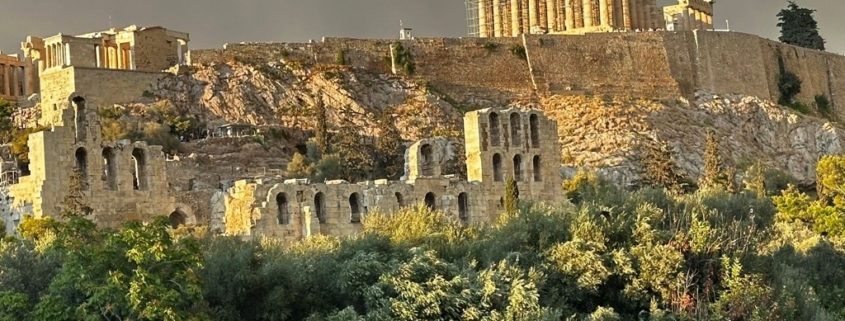An Odyssey: Is This How Ulysses Traveled?
Travel has always been intriguing to me. My wife, Linda, says I have true wanderlust. So, when we were invited by our friends Pat and Kristin to go on a cruise to Greece, Croatia and Italy, it didn’t take long for us to say yes. Even though we’re not cruise people. Well, we weren’t cruise people. Andy maybe we’re still not cruise people because it’s hard to describe a Silversea experience with the word cruise. It’s more like they took a resort and floated it from exotic port to exotic port. With just over 350 guests and nearly as many staff on the Silver Whisper, it felt like you were on your own private yacht with a few of your friends. Never did we have to hustle to find a seat, get a cocktail or whatever. Most of the staff knew our names by the second day and knew our preferences when it came to just about everything.
A flight from Philadelphia non-stop to Athens on American was the start. While American isn’t a great airline, they got us there without incident and on time. And that’s when the amazing started. Silversea means it when they say, “door to door.” Clearing immigration, there was somebody there to meet us, and that was a theme throughout the trip. Somebody was always there. No matter what we were doing, somebody was always there. A bus ride to the Grand Bretagne hotel, set up by Silversea, and there was somebody waiting there to check us in and give us instructions and the itinerary.
Having been to Athens a few times, it was fun to see Pat and Kristen there for the first time. I’ve always said Athens is just a “day and a half” town, and I still believe that. A walk to the original Olympic stadium followed by a stroll through the Plaka (maybe including a meal), a visit to the Parthenon and a tour of the Acropolis Museum is just enough as a precursor to heading to the Greek Islands.
I spent some time that afternoon with my friend Pagniotis, a fellow pilot who I flew with on one of our trips to Greece. He lives in Athens, but he got his MBA from JU, so we have a lot to talk about and we did just that for a few hours over some Greek, “Alpha” beer. He has a Cessna 182 that he keeps in Athens and does a lot of flying for their version of the Civil Air Patrol, looking for fires in the countryside. He also makes some trips to the islands, and I keep threatening to come back and fly to my family’s island of Ikaria one day soon. As he left, he brought me some Galaktoboureko, a Greek dessert my grandmother used to make. Very kind.
That evening we did take the advice of the hotel’s concierge for a restaurant, and it was pretty amazing. On a veranda at the base of the Acropolis with a view of the Parthenon, it would be hard to imagine it any better. Follow that with some authentic Greek food, including moussaka, and it proved to be a perfect jumping off point prelude to the next two weeks. As in, I ate too much.
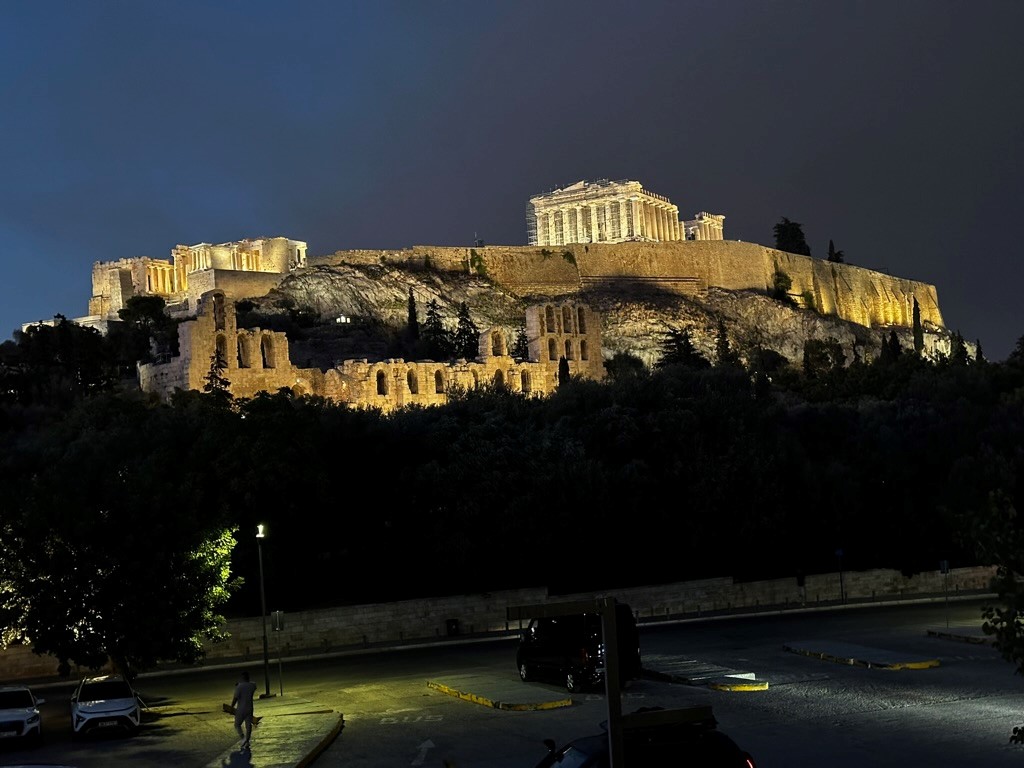
Breakfast on the veranda of the hotel, again overlooking the Acropolis, was a buffet combination of the things you’d expect and Greek specialties.
And again, somebody was waiting for us when we made our way to the lobby to catch the bus to Piraeus, the port of Athens to meet our ship, Silver Whisper.
“Are Mr. and Mrs. Rainey and Mr. and Mrs. Kouvaris on board?” was the question asked by the Silversea representative who boarded the bus when we arrived in Piraeus. We figured we might be in some kind of trouble but unbeknownst to us, Pat’s company does some work with Silversea and a few of his colleagues had called ahead to let them know we’d be on board. I’d say we got some VIP treatment, but everybody on board gets VIP treatment. Julio, the Hotel Director, escorted us on the ship and each day checked in with us to see how it was going. We felt connected for sure as he arranged for a “back of the house” ship tour (which was amazing) and a tour of the bridge. I’ve been on the bridge of a few US Navy ships in my job as a reporter and Pat made a 26-year career out of the Navy, so the bridge was particularly interesting with very few people up there and lots of cool technology. Pat was particularly impressed, and took special notice of the hour-long checklist used each time we got underway.
There are thirty nationalities represented among the staff on the Silver Whisper. Literally from all over the world, but we didn’t meet one staff member from the US. As we listened to Julio talk about the crew, it was obvious they’re spending a lot of time, effort (and money) training and retaining the best people. It really struck me how everybody seemed to really like their job. Without fail, and without hesitation, they fulfilled every request across the board and did it all with a smile. Julio’s assistant, Matteo, became a quick contact and a friendly face we leaned on throughout our experience. Maybe he’s that way on every trip, but we seemed to hit it off almost immediately and he never acted too busy to sit and chat and occasionally share a cocktail with! It seemed like we’d been friends for years. Same with Julio, same with Dinesh and even with the Captain.
Traveling with another couple for more than two weeks could be tricky, but the easy and comfortable nature of our friendship made it simple from beginning to end. As is generally the best policy, everybody does their own thing, and everybody’s invited. Lucky for us, we all did most of the same things together and enjoyed the experience and the company.
With Linda and Kristin not feeling particularly well on back-to-back days to start the trip, Pat and I passed the time hanging over the 10th deck railing watching the Captain and the local pilot navigate out of Piraeus, sitting on the “fantail” and watching the world go by. Luckily, both of our wives recovered quickly.
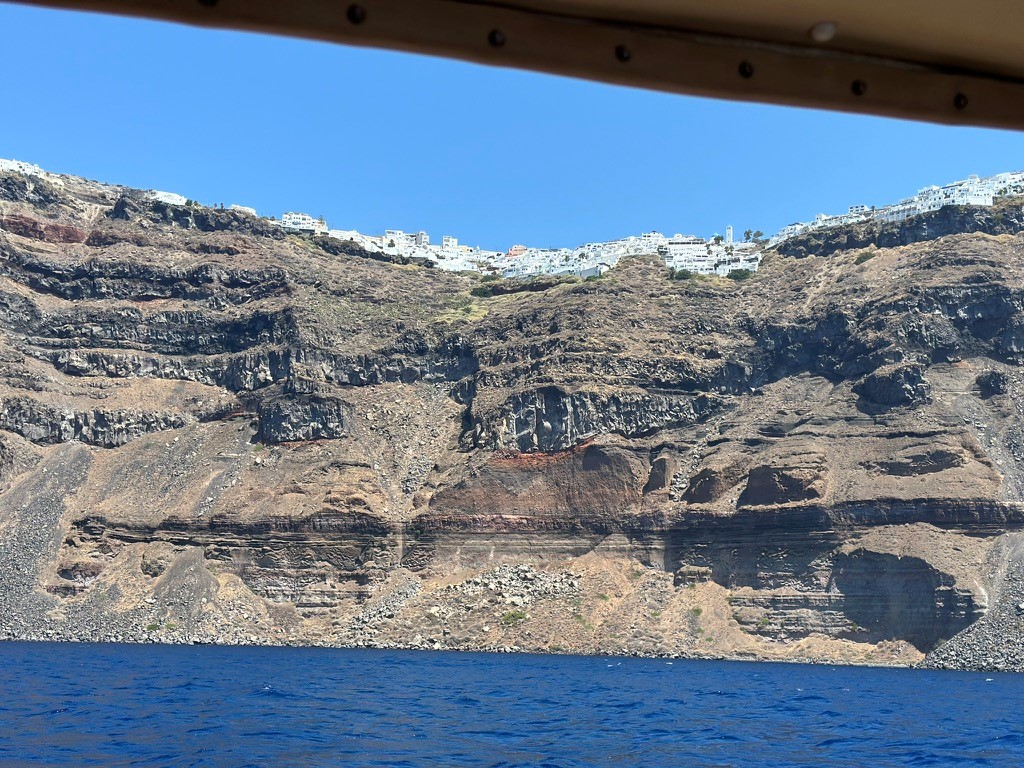
Generally, the Silver Whisper sailed at night for this cruise. The first port of call was Santorini. While it’s a Greek island, it’s not very representative of the rest of what’s happening in the Aegean. Pat and Kristin had an all-day excursion planned and with Linda not feeling well, we stayed on board. I decided to venture out to meet them in Oia, a familiar spot on the island, having been there several times. Santorini has always been tourist-y but recently, it’s exploded. I boarded the tender around 12:30, only to be greeted by the sight of three massive, 5,000 passenger cruise ships in the caldera. (Basically, Santorini Harbor). There’s a cable car that takes visitors up the sheer face of the island that was torn apart by the volcano blast in 1600 BC. They used to allow buses and taxis down to the port, but no more. It’s the cable car, the famous, or infamous donkeys, or walk. When I arrived, the line for the cable car was about 2 ½ hours long. I passed on that and looked for the stairs. While the temperature was 96 in the shade, the humidity was Jacksonville-like as well. So, after about three switchbacks, drenched and looking for shade, navigating the donkeys carrying tourists up and avoiding the ones coming back down on their own, I was questioning my decision-making. After my foot being stepped on by a donkey for the second time, I had a serious discussion with myself about turning around. But I pressed on, a little dizzy from the heat and the smell of donkey dung. By the way, if you want to hear complaining in just about every language, do this one time!
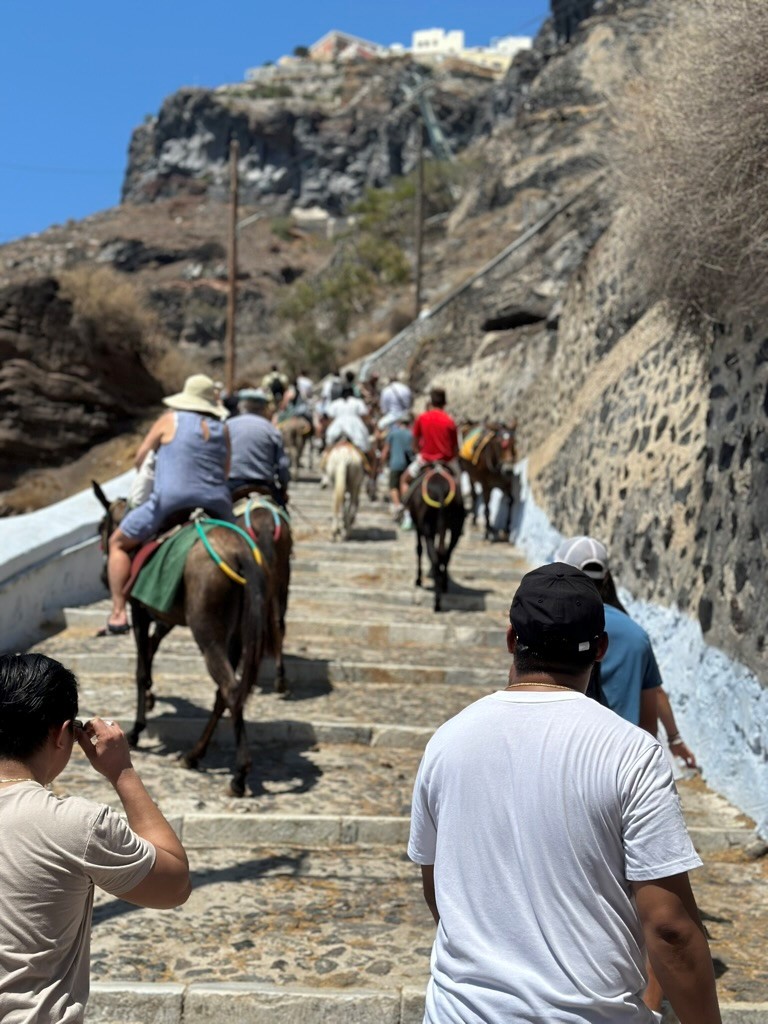
At the top of the climb in the town of Fira, (the Greeks also call the island by that name), I figured I’d grab a cab. Pat and Kristen had settled into a nice, shaded, outdoor café near the main church in Oia, so they’d be easy to find. Problem was that the mass of humanity in Fira made it nearly impossible to navigate. With a little bit of the Greek, I know coming back to me, I managed to ask a shop owner where the taxi stand was. Another ten minutes, up and down stairs and downing a giant bottle of water, the friendly cab driver told me in both Greek and English, “It’s a big car. We need to wait on more people.” I wasn’t up for that and decided to head back to the ship.
Not willing to walk back down, the line for the cable car was only about an hour, so I joined in with the other folks headed back to their ships. If you’ve traveled in Europe, you know that certain parts have their own ideas about getting in line. Sometimes it’s a free-for-all, and others it’s very orderly. This line snaked around a building and up to a gate and seemed to be going pretty well. As I approached the entrance, a group of Romanians came from the side and squeezed their way through with no regard for the line or the people in it. The group of Japanese in front of me were none too happy and even the Italians behind me, not normally know for queuing up were pretty vocal. That didn’t deter the line cutters who ignored everybody around them. When Pat and Kristin made it to the line, it was also about an hour, but they befriended a Hungarian who appointed himself the line police. “Nobody got by him,” Pat said with a laugh when they got back to the ship.
We left Santorini around ten, and with our wives recovering, Pat and I sat on the back of the ship watching the lights of the island fade into the darkening night. Santorini allegedly is going to restrict the number of tourists to 8,000 starting next summer, which will alleviate some of the issues we encountered. “What’s the deal on those big ships,” Pat asked. “They’re just massive!” “In some cases, they qualify as Dante’s Fifth Level of Hell,” I answered. That’s pretty snarky I know, and snotty as well, but wow, those people were having a very different experience than ours.
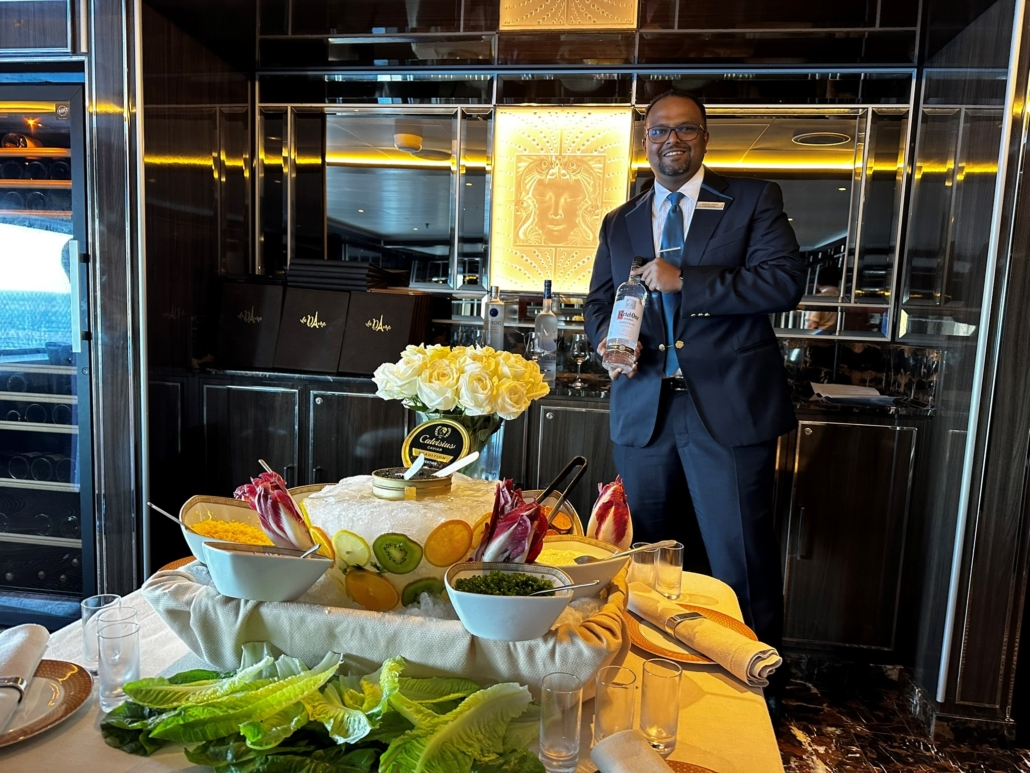
A scheduled day at sea followed as we made our way around the west coast of Greece. Onboard, Matteo and company had noticed our interest in vodka, and not just drinking it. They set up a “vodka” tasting for us, and while our wives declined, Pat and I eagerly made our way to the restaurant “Le Dame” to see what they had in store. The Chef had put together a beautiful presentation of all the accoutrements that go with a vodka tasting. Starting with a tin of caviar on top of a beautifully molded bed of ice, he had and side dishes, of chopped eggs, tomatoes, onions, basil and just about everything else you could think of that could top a serving of caviar. Dinesh brought three different bottles of vodka: Ciroc, Grey Goose and Kettle One, and explained the history of each, the distilling processes and ‘purity’ for lack of a better word. We did a tasting and were surprised at the difference in taste each offered, which was best on the rocks or chilled and neat and which was best for mixing (Kettle One.) Who knew! The fun part was having several officers of the ship along to witness including Chef, Julio, and Matteo. It must have been something different because the Captain showed up and sat with us for twenty minutes or so. Being of Polish decent, but not a vodka drinker, he gave us some background nonetheless, as well as some of his history. Fascinating stuff.
We found ourselves in Corfu (or Korfu or Kerkira to the Greeks) the next morning. We docked on the east coast of the island. I had been to the west coast, a very different experience than the bustling business, tourist and economic engine of the island. It felt like we were in a movie as we boarded a bus for the morning excursion. Our guide was very friendly and knowledgeable, but she looked, talked and acted like she was right out of central casting. “I guess we’re now ‘boat people,”’ Kristin said as we all laughed in agreement. We wound our way up to the “Mon Repos” (My Rest) palace, stopping along the way at scenic vistas. It was fun to see airliners on final approach to Corfu International go by from a thousand-foot perch overlooking the harbor and the airport. Yugoslav dictator Marshall Tito visited Corfu once and it was interesting to see a security bunker he had built for his visit. Apparently, he wasn’t happy with the safety the Greeks could supply and was so fearful of assassination (from his own people) that a fortified building had to be erected for his visit. We finished with a visit to a distiller. It seemed pretty hokey at first, but we ended up buying some limoncello you can’t buy here in the States.
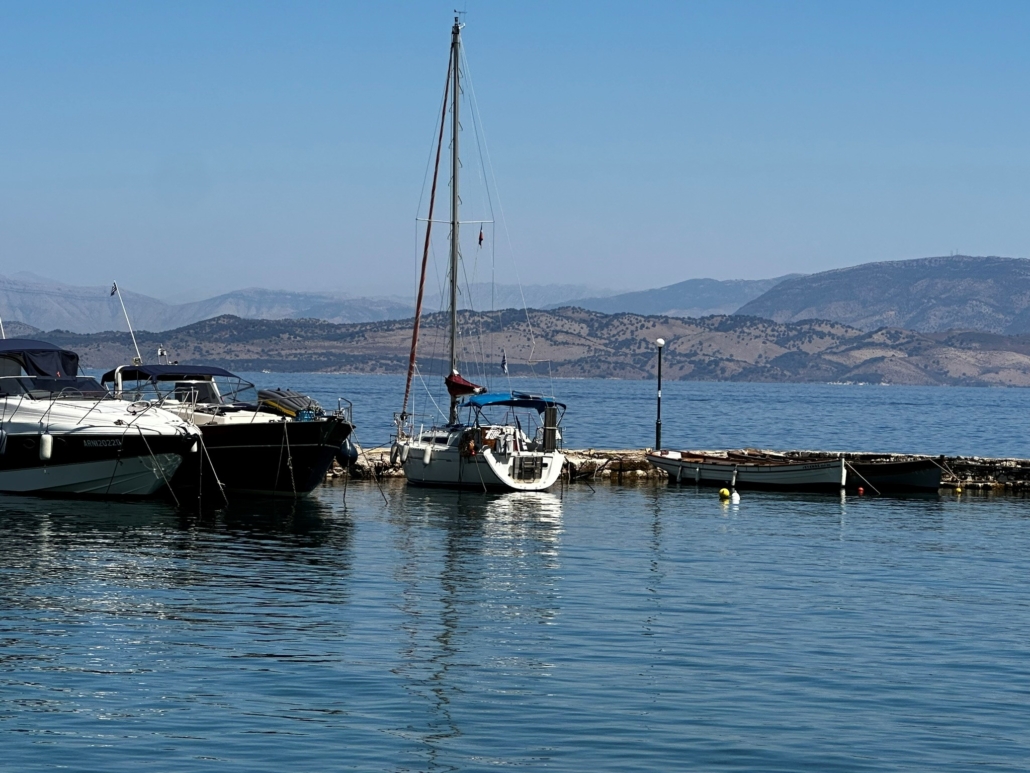
There are thousands of years of history in Corfu and the culture is a mix of Greek and Italian as well as influences from many of the other conquerors of the island. Near the main fort, Kristen made a reservation at the Corfu Sailing club for lunch. Getting there was tricky but what a hidden gem! We ate right on the water where hundreds of boats were docked. The food was fresh and authentic, and the Greek white wine was just right. Drinking Greek wine can be somewhat of a roll of the dice. If you catch the right bottle, it’s delicious. But quality control isn’t their strong suit.
Traveling on a small ship has its advantages as far as navigation. You can go to ports where other ships can’t or aren’t allowed. That’s the case with Kotor, Montenegro. Kotor is well inland but accessible through an inlet and then the length of Kotor Bay. Never heard of it? Not to worry, not a lot of American’s are aware of it or even could point Montenegro out on a map. Navigating through the straight early in the morning was tricky but beautiful with mountains rising directly out of the water on both sides. There were plenty of apartments, condos and hotels along the coast on the way in, occupied throughout the year by Europeans, the Brits and even the Chinese in the winter months. It was stunningly beautiful. Silver Whisper was assigned the premier docking spot, pier side right by the Old Town. Another cruise ship was moored well off the harbor, a 45-minute tender ride to shore. Having been part of Yugoslavia and Serbia through most of the 20th century, the country was hidden from tourists from the west and particularly from Americans.
So. as visiting Montenegro is new to us, we’re also new to them. They admit American tourists are something new and somewhat of a novelty. Pat and I walked around Old Town, a walled city full of shops and eateries. It was very hot that day, so we sought some shade and headed back to the ship. Kristin likes to research restaurants in different spots, so we headed to “Moments” for dinner. Normally a five Euro cab ride, it was 40 euros to get there at rush hour. Tucked on a main street overlooking the harbor, the restaurant was eclectic, and we ate on the second-floor garden veranda with a great view. You could tell we were somewhat of a novelty to the wait staff. I walked down to the bar to see what kind of vodka they might have, and the bartender was guarded and defensive at first. His English wasn’t great, but when he finally realized I was just generally interested and not criticizing anything, he was very engaging. They had some Beluga Vodka, and I found out they had just opened a distillery in Montenegro, so you couldn’t get much more local than that.
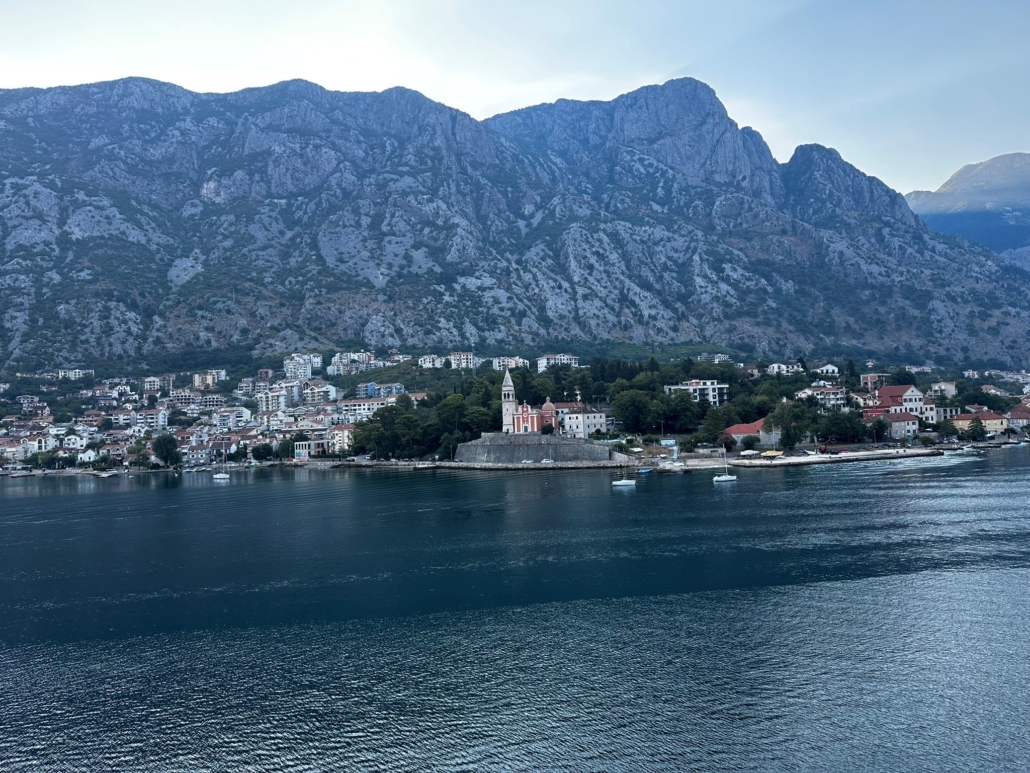
Dinner was fresh and fun with a local family with two young kids seated nearby. Before we paid the bill, the young owner came out and spoke with us. He was very engaging and while his English was very good, as occasionally happens, he couldn’t quite find the right phrasing in translation, so he blurted out “Why are you here?” Processing what he was actually asking, we figured out he was curious how four Americans ended up in his restaurant. We explained how Kristin had found it online and how great our experience had been.
“We’re getting better,” he said referring to the country as a whole while explaining he had been open only three months. “You know, the politicians are bring us out of it,” he explained. “Pretty much our whole country was built on the drug trade in the past,” he sighed. “Oh, kind of like Miami in the ‘80’s,” I said with a laugh, which seemed to lighten his mood. It was fascinating to have a conversation with a young entrepreneur who was really trying to make a go of it. Hope he makes it.
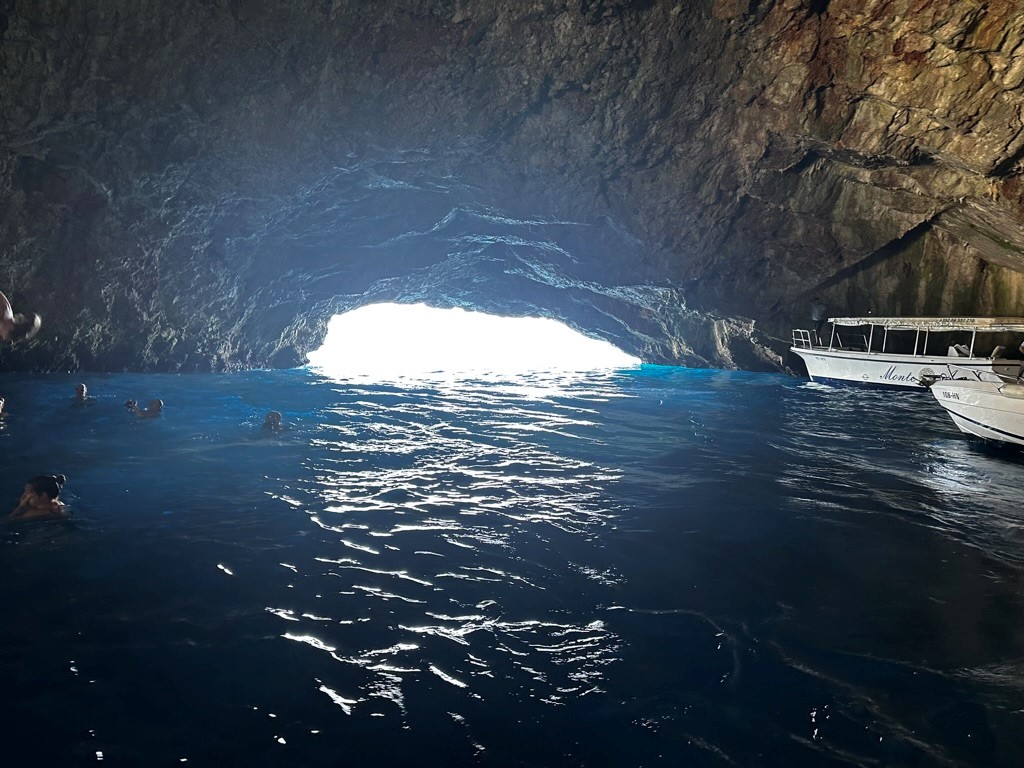
Our excursion that day was a fast boat ride out to the “Blue Cave.” Cruising through Kotor Bay was beautiful, and we noted the number of condos and apartments lining the waterfront. The Blue Cave was interesting, a slightly downgraded version of the “Blue Lagoon” off Capri. The boat stopped and some folks jumped in the water. We waited for the beach stop, about 20 minutes later and were rewarded with clear water and a refreshing swim in the sea. Since the Adriatic doesn’t have any waves, the beaches are all dirt and rocks, some artificially brought in. That makes it hard to walk around and get into the water. (Pro tip: Bring water shoes!) I did manage to make it into the water and really enjoyed it. On my way out, I was clearly struggling, new knees and hips and all, so a nice Australian fellow traveler came down the shore and threw a towel down so I could more easily walk out. Somewhat embarrassing, but when he said, “No worries mate, that’s what I brought it for,” I felt better. A bit like Dudley Moore in “10,” without a vision of Bo Derek in my head.

Departing the port, our wives called it a night so Pat and I sat on the “fantail” watching the navigation through the bay and the channel in complete darkness. There were times where there wasn’t much room to fit the ship through. When we mentioned to the captain the next day what a good job the navigator did, he smiled and said, “I did that. Pretty tricky to find the channel at night.” We all laughed. With plenty of respect.
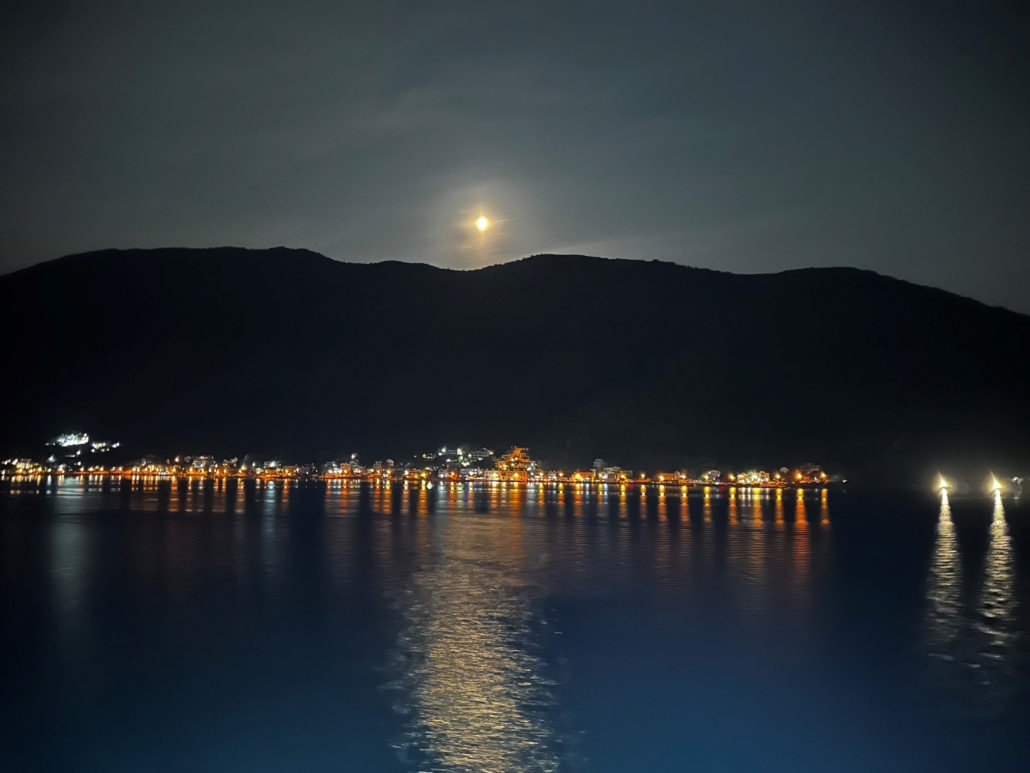
On a side note, I thought I saw Shad Khan’s new yacht, Kismet, going past Corfu. I sent him a note when I realized it was docked in Montenegro. Shad keeps the boat for himself when he wants it but makes it available for lease in the weeks he’s not on board. “I know it would be a small chance we both were in Montenegro at the same time but are you here?” I asked. “Small world. I just got off the boat. Safe Travels,” was his response. I don’t know who was on board, but Shad has mentioned in the past that Kismet “has become popular in those circles.” Those circles, at $3M a week to start, include Bill Gates and the King of Saudi Arabia. Small world indeed.
It was a short sail to Hvar, another one of those small ports we were treated to because of the small nature of our ship. “It’s the new Portofino,” Julio said when asked about the town. “You’ll see all kinds of yachts there.” And he was right. Roger Penske’s yacht along with several that were registered to Russians were in port. A tender ride dropped us off in the town square. Pat and Kristin had gone ahead to do some shopping, so Linda and I went off on a walk. As we are wont to do, occasionally we just keep walking. And in this case, we ended up at the top of the town at the fortress overlooking the Adriatic and the city below. You could say it was a bit of a hike, but well worth it. We met them at a lunch spot Kristin picked out, and again, not disappointed. Eclectic and built into a hillside, the food was fresh and delicious. Must be something about the water there.
A trip across the Adriatic was uneventful to the port town of Monopoli. Situated between Brindisi and Bari, Monopoli has a walled city adjacent to the harbor with plenty of shops and restaurants inside. It again was stifling hot, but the occasional nice breeze made it bearable. At least the visitors all acted like Floridians and realized the best tables were in the shade. The town is surrounded by big concrete slabs piled in the water. Their “beach” was comprised of each slab, that usually had a couple perched on top with towels, sunscreen, snack and drinks. The swimming in the Adriatic was fun, even off the back of some large boats anchored offshore. Pat and Kristin found a small café/restaurant in the old town for lunch. They raved about the meal, so much so that Pat has tried to replicate it in his own kitchen! Monopoli is becoming more popular as a spot for local Italians to vacation. Nice, quiet and small, ideal for a stop for a small ship like the Silver Whisper.

Because of the way Silversea scheduled this trip with most of the sailing done at night, it was exciting each morning to throw open your curtains and see where we were. It was nearly breathtaking our next morning when the sunrise revealed Dubrovnik and its shoreline simmering in the near distance. Even if you’ve only seen a snippet of “Game of Thrones,” at first glance when seeing Dubrovnik you think, “That’s Kings Landing.” Although the producers, through movie magic, made it about ten times its size, Dubrovnik was unmistakable with its position on the coast and the red-topped roofs from the old harbor to the hills.
Both the included and the ad- on excursions on this trip were well done by Silversea. It’s clear they vet the tour providers and with tourism the lifeblood of most of the Adriatic’s coastline economy, tour guides and operators are doing their best to accommodate the guests. Our pre-arranged walking tour of Dubrovnik started early, which was fine to avoid the mid-day heat. Our guide, a young woman who was multi-lingual, (she spoke at least English and Croatian and taught French in school near the city) was knowledgeable and polite as she guided us through the narrow streets and history of the 1300-year-old city.
Pointing out one of the many historic buildings and churches inside the city walls, she casually mentioned, “And this is where my family hid during the war.” Wait, what? “Oh yes, my mother and my sister were up this street with our cousins while my father was off fighting,” she explained, as if she was talking about going out for gelato. “But then it got too dangerous here and we fled to an island for a year and a half.” Pressed for more she offered, “When we came back, I was laying on the beach over there with some of my friends when some shells came over our heads and landed in the sea. We grabbed our stuff and ran to a shelter.” We were just shaking our heads, especially realizing this was in the early 1990’s, not some distant conflict where the details are forgotten.
As a fighter pilot in the US Navy, one of Pat’s missions was to enforce the “no-fly zone” over the Balkans during that war, flying off an aircraft carrier in the Adriatic. So, if you connect the dots, it’s entirely possible that he and his squadron mates were, in some part, responsible for this girl’s safety. Listening to her talk deepened our desire to be travelers and not just tourists.
More cobbled streets and steps followed, and led us to a convent/monastery built in the 1500’s. Any thoughts of “ho-hum, another church,” were allayed when she explained that the well in the courtyard, built there over 400 years ago as a safeguard against invaders, had never been used until the siege of Dubrovnik, just 30 years ago.
That conflict is still evident as you walk the narrow streets and alleyways. While the buildings have been mostly repaired from damage caused by ordinance lobbed into the city during the siege, there are still pockmarks on the walls from shrapnel flying three decades ago. We found a nice, shady spot for lunch, and while drinking Croatian white wine and waiting for pizza, Pat found a website on his phone that outlined the spots where shells hit during the attack. “This one is right there,” he noted, pointing not ten feet away from where we were sitting. Amazing. And chilling.
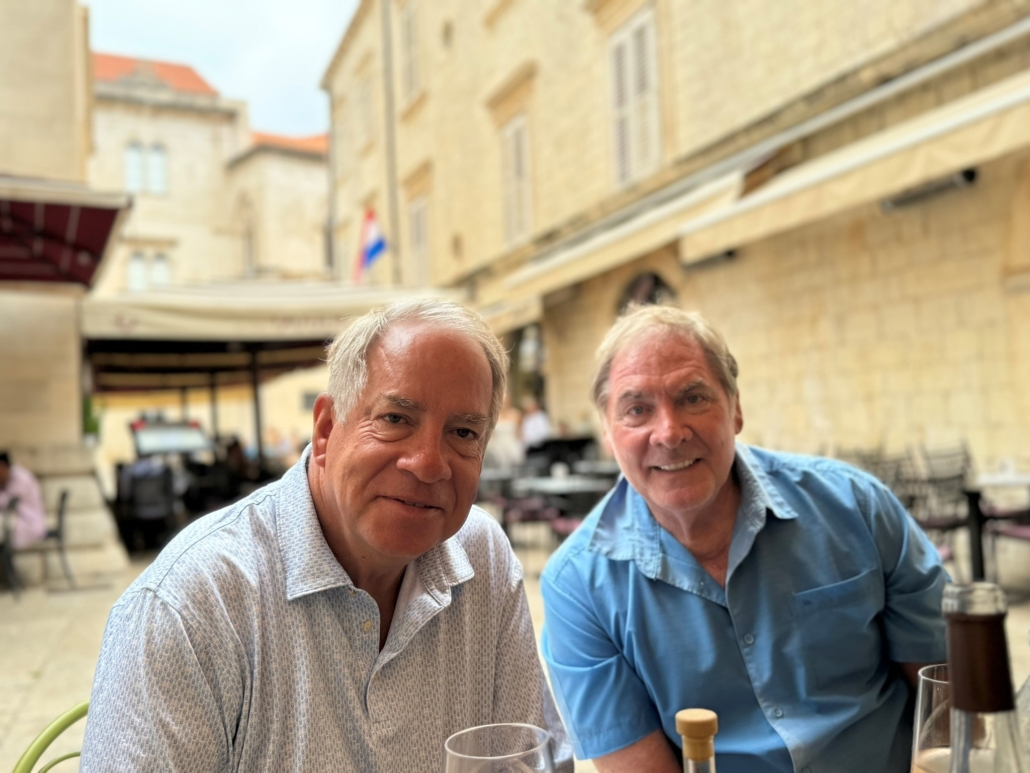
Looking for some artwork, Pat and Kristei strolled through town, eventually finding what they were looking for and even went back into the city that evening to meet the artist and have dinner. Linda and I opted for getting cleaned up and watching the sun set over Dubrovnik from the fantail (officially called the Panorama Lounge.)
Living in Florida, we see plenty of violent weather with crackling lightning, crashing thunder and slashing rain. You watch it go by; generally glad you weren’t caught outside without some shelter. So, at sea on the overnight trek from Dubrovnik to Split up the Croatian coast, I was glad to have met the Captain and knew his level of experience and confidence. Our cabin had some front facing windows as well as a sliding glass door out to the balcony and those widows gave us a vision of the light show and the kind of weather I’m sure you only see at sea. Lashing rain, dramatic lightning and thunder cracks that woke me up were part of the show in the middle of the night. While the Silver Whisper was plenty stable and sturdy, the weather was all over the place. One minute you couldn’t believe how hard it was raining, the next it seemed as calm as a spring morning. Only to be followed by a lightning bolt that lit up the night and a crash of thunder that rattled the windows. And I guess this is normal at sea, it was over. Whatever system we were sailing through was now behind us, and a few more hours of shuteye beckoned.
Opening the drapes in the morning revealed a dreary, rainy day in Split. While we were pier side, the harbor was bustling with activity, ferries carrying passengers and vehicles coming and going with regularity. We had a scheduled excursion so after a quick breakfast and coffee, we grabbed the Silversea provided umbrella’s and ventured out into a light drizzle.
Undeterred, our tour guide handed out listening devices and started us on a walk through the scenic parking lot. As the rain grew harder, we all looked at each other with an “I don’t know,” shrug and kept moving. The guide was happily chatting away, and honestly, I couldn’t really catch a word she was saying except, “The castle is over there, across from the bus stop.” Not much on history but at least instructive.
As the eventual retirement home of the Roman Emperor Diocletian, the castle was in remarkable shape, especially the lower, underground rooms, recently excavated after centuries of serving as a waste dump and landfill. It’s no wonder they figured that was the best use, because the humidity had to be 100% while we were in there. I’m sure it was just as humid in the 3rd century when they were building it. Seeking any kind of fresh air, we were glad to finally climb to the surface. There, the residents of Split have commercialized almost all of the castle with shops and gelato stands. Some high-end retail is also there but because of that, it wasn’t impressive at all.
And for all his accomplishments, and there were many, Diocletian isn’t highly regarded in the history books because, one of his last acts as Emperor was to ban Christianity. That didn’t work at all. He also tried price controls to curb inflation, and that was a failure as well.
“I think she’s a sub,” was the consensus from our group. The guide didn’t quite meet the Silversea standard so we figured the regular guide must have called in sick that day. Once we arrived at the “Taste of Split” portion, an olive oil tasting, we were at least out of the rain and in their version of AC. While we were seated, the guide trolled by three times looking for a gratuity, but none was forthcoming. At least the Croatian olive oil tasting was educational, and we even bought some to bring home it was so delicious.
It didn’t seem too inviting to stay in Split, so we headed back to the ship. That’s one of the good things about the whole Silversea experience. The ship is always an option. Whether it’s lunch, a cocktail, dinner, the gym, a nap or just sitting by the pool, the atmosphere, the food and the service are unparalleled. Within a day, every one of the service personnel called me by name. They knew I liked a lemon, and Pat liked a lime in our cocktails. They knew the difference between a Hugo Spritz and an Aperol Spritz and prepared them expertly. They knew we liked potato chips. Sounds silly, but when you’re on board for eleven days, the personal touch makes it very comfortable.
There are four restaurants aboard the Silver Whisper. All with plenty of variety and plenty of space to accommodate everyone onboard. Which is probably why we ate most of our dinners on the ship.
“Le Dame” is the only restaurant with an upcharge ($60 per person). The food is French, and fancy and the service is over the top. I’m glad we went there one night for the experience (and the Dover sole was fab) but I didn’t need to eat there more than once. You can dress up for dinner on the ship, and you can even go very dressy on “formal” night but generally the only requirement is long pants and a collared shirt. Pat and I wore a suit one night and sport coats a few others, including the night we had dinner with the Captain.
That meal was in “La Terraza,” an Italian restaurant that’s a staple on all Silversea ships. Well prepared Italian dishes where the lasagna was a favorite in our group. Simon, our waiter, seemed genuinely pleased every night we showed up. We ate there plenty and it’s a place you could eat every night. Francesco, the sommelier, chose nice wines to compliment the evening dishes, all included. And if you decided you wanted something more specific, the wine list had plenty of great, and somewhat affordable options.
When we inquired about wines a few nights in a row, Francesco suggested he put together a wine tasting for us during the trip. One afternoon, he hosted a very nice get together with eight passengers and a tutorial on French Bordeaux’s. Complete with a small charcuterie board at each seat, he passed along a lot of knowledge without getting too far in the weeds. As good as they were, both from the right and left bank, and as proud of those wines the French are, I’m still stuck on Italian. Somebody needs to drag me out of that.
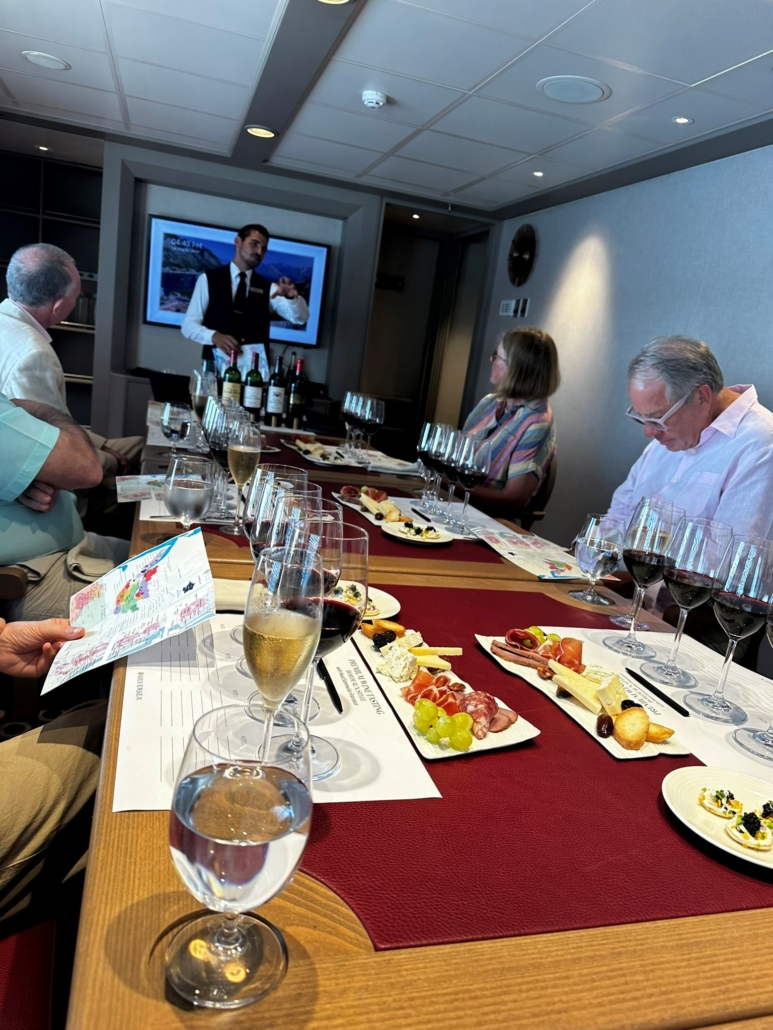
They’re trying something new at “The Grill,” their restaurant that’s on the deck of the pool, transformed with white tablecloths to the floor in the evening. They heat stones to cooking temperature and put them in front of each patron, placing your order in front of you, cooking before your eyes. It’s novel, but between wearing a smock and all of the commotion, we agreed that giving the option to have the meal cooked tableside, or even in the kitchen would have been nice.
Calling the open seating restaurant, “The Restaurant” doesn’t do it justice. It’s the only place that doesn’t require a reservation because it’s big enough to handle whoever happens to wander in. It’s a beautiful room at midships, and with a different menu each night, including local dishes from the port you’re in, there would be plenty of variety to eat there every night if you liked. The service was also fabulous.
Looking out the window the next morning, a flatter coastline and the city of Zadar stretched out across the bay. It was the first time the ship has docked at the pier on the starboard side, so I wasn’t sure what the town looked like until I made my way up to the gym on the ninth deck. Zadar (pronounced ‘ZA-dar’ with a little emphasis on the first syllable) is another one of those tiny ports that only a small ship can get into. We were docked next to a public space that included a solar powered night light show, a sea organ (where the movement of the water against the dock forces air through different size holes in the pavement, creating music) and a public swimming area on the waterfront. The Adriatic is so clear, and blue on that side, that laying a towel down right on the sea walk and jumping in is pretty normal.
We cancelled our excursion that day in favor of our own stroll through the old town. A cool little city with a very historic church dating back to the 10th century. St. Mary’s church had a fresco that was in good shape that was more than 500 years old. And it had an altar dedicated to the souls in purgatory, something I’d never seen, even in my years as an altar boy.
Pat had arranged for a “tuk-tuk” tour around town at sunset. Our guide was a 20-year-old history student at the University in Zadar, who wanted to be a history teacher. Really informative, inquisitive about The States (Is it safe?) and made it to a hilltop just in time for sunset. It must be a famous place to see the sunset, because there were plenty of other folks there as well. Our guide informed us that Alfred Hitchcock said it was the most beautiful spot for a sunset in the world. So, they have a Hitchcock festival in town every year. It was spectacular. We asked about sports in Croatia, noting that their World Cup Soccer results are outstanding. “We’re good at football,” he explained, “But we’re a basketball crazy country.” That’s when he pointed out all of the courts in town, the indoor facilities and stadiums dedicated to basketball. “The average male height in Croatia is 6’1”, so we all play basketball.”
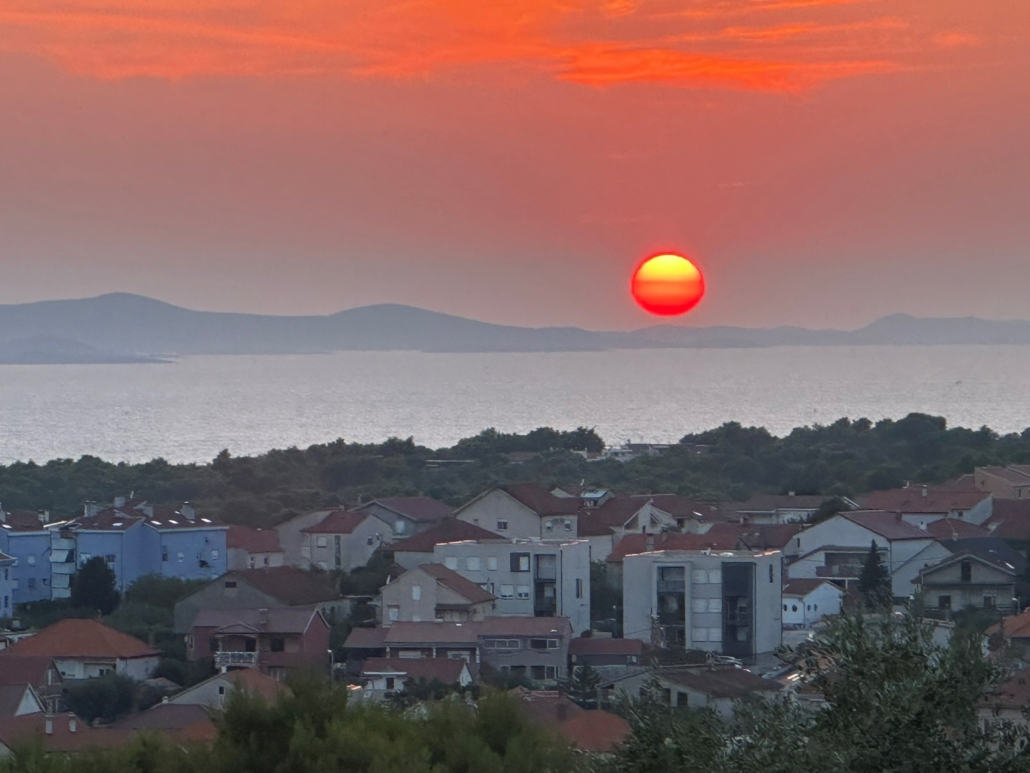
Our next morning found us in the harbor off Rovinj. It’s a Croatian town on the Istrian Peninsula and right across the Adriatic from Venice. Since the Venetians ran this part of the world for centuries, it’s no surprise that Rovinj (or Rovenia as the Italians call it) has Croatian and Italian as their dual official languages. Pat and Kristin went on a tour of the town while Linda and I had signed up for sea kayaking through the archipelagos off the coast. A fast boat ride to a nearby beach lined with kayaks was the prelude to a safety and instruction briefing and off we went into the Adriatic. We made our way around three islands and to a remote beach with an observation tower. “That small island is where they stopped ships during the Plague,” our kayak guide explained. “We did the same during Covid,” he deadpanned. Unmatched view and our guide even climbed up a grapevine trellis to grab bunches of grapes for each kayak off the vine. We had an hour on the beach, so we got in the water, refreshing, and buoyant. Now knowing to wear shoes, I had my boat shoes on, and much to my delight, they floated my feet right to the top of the salty Adriatic. I swam a bunch and floated plenty, only checking occasionally that I wasn’t being swept out to sea. Returning to our kayaks, the trip across the strait against the tide and against the wind was tricky, but by then we had gotten the hang of it.
Pat and Kristin found a small café for lunch and went exploring. They got a little lost, which is part of the fun, but found their way back without incident. “I could live here,” Kristin said without hesitation that afternoon. “There’s something about this place that really appeals to me.” And you could see why. Balmy and beautiful with a mix of cultures, the residents there were living the Croatian version of “La Dolce Vita.”
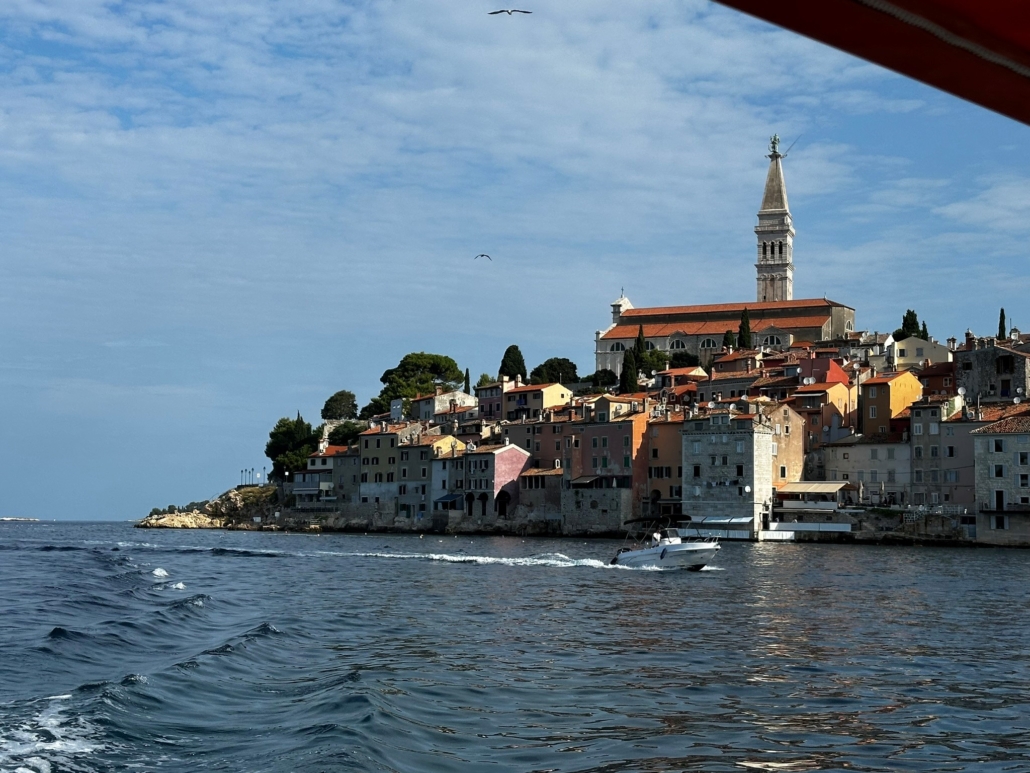
Over to our disembarkation point in Venice overnight, we woke early to the Silver Whisper slowly navigating a canal from the Adriatic to the port of Fusina. It’s as close as any cruise ships are allowed these days. When they were letting the big ships cruise right by St. Mark’s square, they realized the vibration from the engines was shaking the foundation of the city. So, they put a stop to that. As we left the ship, we gave a heartfelt thanks to Chris, our butler, and Daiwa, our steward. Silversea assigns a “butler” and a steward to every cabin, and while the designation might be accurate, there must be a better word for what they do. Chris had the right mix of helpfulness and friendliness, blended with a respect for our space and time. He let us know the schedule each day, arranged meals and anything else you could think of. Usually before you thought of it. He couldn’t have been better if you had built him from scratch. And I know Pat and Kristin thought the same about their butler, Adolph.
As I’ve mentioned a couple of times, it’s the small personal touches that set Silversea apart on this trip. The head of the concierge team, Alessandra, told us not to worry about our transfer from the port to the Maritime Terminal to get our luggage. She also said not to worry about a taxi from the Terminal to our hotels. And as far as leaving the ship she said, “You’re with me, don’t worry about that.” So, after a leisurely breakfast, we disembarked at nine. And like every other time, there was somebody there. They grabbed our luggage and put it in a Mercedes van. They dropped us off at the Terminal, where somebody met us to escort us to the water taxi. And they boarded the taxi with us for the trip to the hotel. It had been a while since I’d been in Venice, so I’d forgotten that using the water for transportation isn’t an option, it’s the ONLY option. You do get a sense of what the explorers and traders have seen for centuries as you approach the city by boat. It took us down a canal and right to the entrance of our hotel. Where, yes, somebody was there to meet us.
We stayed at Ca’ di Dio, right on the waterfront, a short walk to St. Mark’s square. Pat and Kristin stayed at the Hotel Daneli, about a 5-minute walk from us. Both hotels were great. Daneli is a bit more traditional with a beautiful lobby and hotel bar. C’a di Dio suited us perfectly. A little informal, beautiful rooms and a very friendly staff. We found both of those, by the way, on the AMEX travel website.
That afternoon was our “vacation from our vacation” just resting and reflecting on our trip. That evening was a different story.
Pat and Kristin are acquaintances of Joel Silver, a movie director/producer who lives near their home in Beaufort, S.C. Silver had always told them if they were ever in Venice to eat at a specific restaurant and to be sure to tell the owner he sent them. Pat and I called them a month before our trip, only to be told they’d be closed while we were there. But they gave us a suggestion for another restaurant, so we booked that. Little did we know it was on the other side of town, with the only way to get there realistically was to walk. A lot. We walked through St. Mark’s square, through small side streets, over the Rialto Bridge and along what can only be called “alleys.” Pat was guiding through his phone when he turned a corner and came to a stop saying, “Don’t go down there yet.” “Why,” we asked. “Because the guy in front of us has stopped to pee.” While it seemed strange, it didn’t seem completely out of place. When the gentleman finished, we made our way around a few more corners to a solitary restaurant on a very small street. It was obviously a local’s place, perfect for what we were looking for. Nice atmosphere, good food, and we were the only English speakers there. Except for somebody who appeared to be the owner who told me as I was looking at the wine list, “You don’t have to spend a lot of money to get a good bottle of wine here. It’s Italy. Drink this one.” And she was right. Despite the distance, there and back, it was a memorable evening with some of the best octopus we’ve had.
The next day we had arranged for a walking tour of Venice in the afternoon through our friend Amanda Nimnicht. “Meet between the columns in St. Mark’s square,” were the instructions. My mistake that we got there 30 minutes early, so we sat at the nearby café and ordered coffee and wine. I’ve always wanted to have a coffee in “San Marco” since seeing George Segal sitting there in the ‘70’s film “Blume in Love.” Kristin spotted our guide, so she jumped up and brought her to the table. We asked her if she’d like to join us, and she obliged with a bit of trepidation.

Not knowing exactly what we wanted, she started giving us a history of the square and the Doge Palace. Figuring we’d be there at least a few more minutes, we ordered another bottle of wine and listened to her dissertation regarding the centuries of history presented before us. She was rightfully proud to live in Venice and recounted the customs and traditions as well as the riches her predecessors amassed as traders in that part of the world. Two famous columns frame San Marco square from the sea and she pointed out that between them is where justice was handed out after rulings came from a small balcony at the Doge Palace. “Venetians never walk between the columns,” she noted, handing over a pro tip. “That’s where they executed people, it’s bad luck,” she explained pointing to a spot not thirty feet away.
We walked through St. Mark’s Basilica with our guide explaining the artwork on the walls and ceilings, the history of where the different materials came from and the storytelling, mostly of Christianity, that adorned the building. The closer you got to the altar, the more intricate the marble and the artwork. Linda joked you could take a whole semester of a class on the Basilica alone. “Yeah, but when you’re that age, you’d go, ‘Nah, I’m not taking that,’” I said with a laugh. I’ve been to a lot of churches, especially in Europe. That one really stands out.
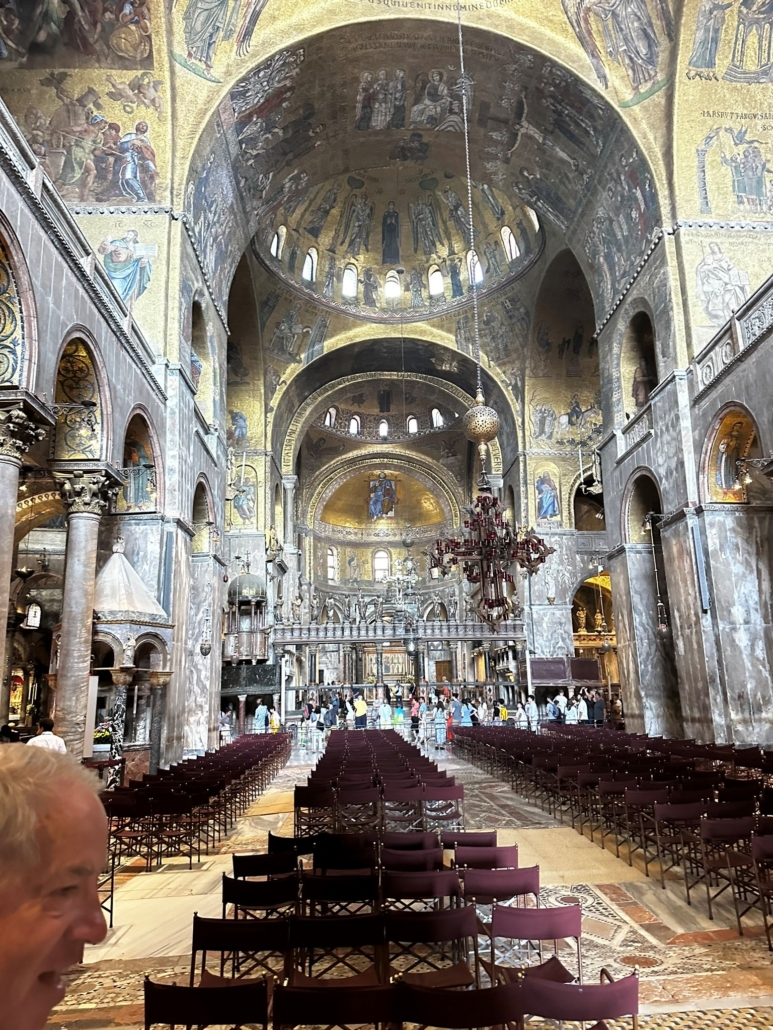
We walked with our guide through the streets of Venice, onto a rooftop with a view of the city that was pretty special. She pointed out the best gelato in Venice, but the line was too long, so we moved on. We made our way back to the waterfront where a traditional wooden boat awaited for an on the water tour of the Grand Canal. It’s amazing that places built as residences in the 1300’s in Venice are still occupied as apartments. As American’s, it takes a minute to wrap your head around that. The boat tour was fabulous. Highly recommend.
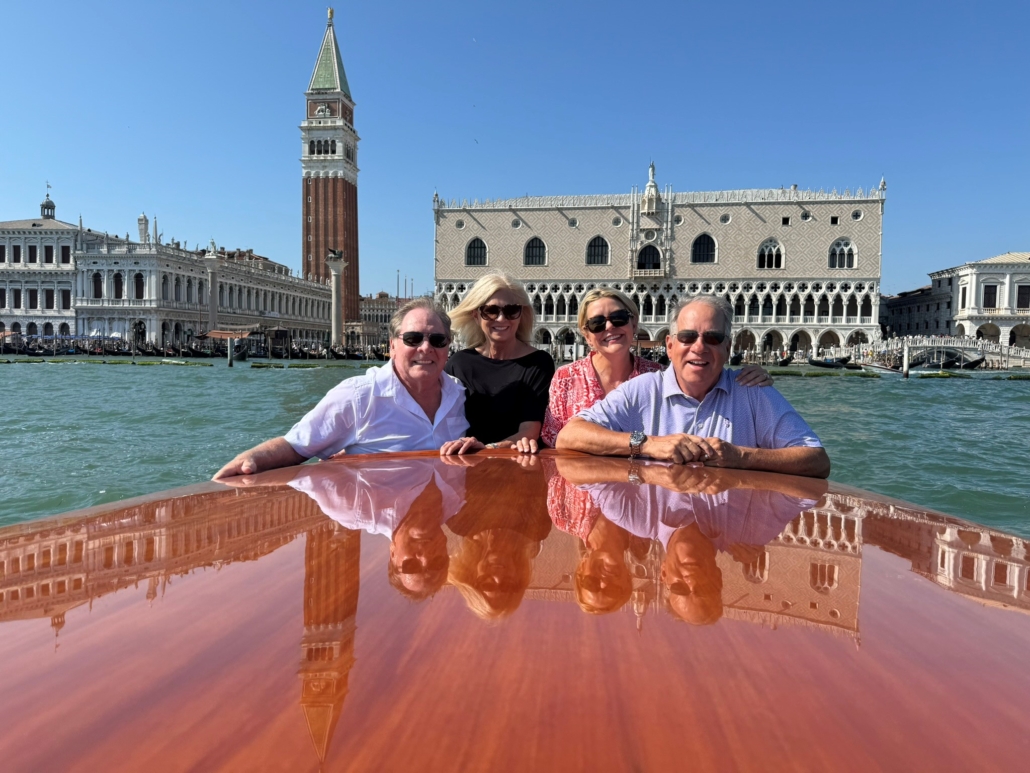
That night we were looking forward to our farewell dinner rooftop at the Hotel Daneli. The atmosphere didn’t disappoint, with the skyline of Venice stretching out in front of us. It’s a shame the service and the food didn’t match. Perhaps the only disappointing meal of the trip. It’s such a nice hotel I couldn’t help but think they must sub the restaurant out to somebody else.
The next morning, the water taxi transported us through town, down the Grand Canal and out into the channel to the airport. Again, by water is the only way to get there, so we enjoyed the ride, and I had to laugh when I saw the more than thirty water taxi parking spaces next to the terminal. It was an easy airport to navigate, with the Marco Polo lounge on the second floor a nice respite before the flight home.
Again, American Airlines is a middling carrier, clearly with a mission to move people from one spot to another, just above a “no-frills” status. It did take them 24-hours to get us home between delays and crew assignments. But safe and in one piece, planning for our next trip.

